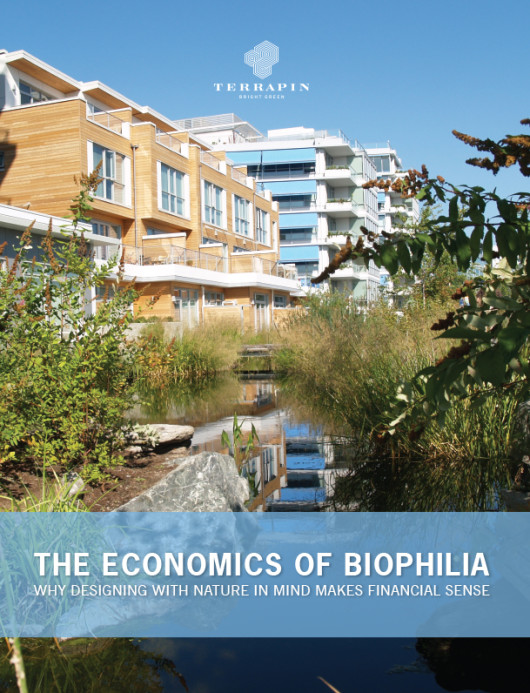Terrapin Report
The Economics of Biophilia, 1st ed.
Why designing with nature in mind makes financial sense
Read the report to understand how biophilic design can improve financial returns and support health and wellbeing. Click here to read more about our biophilic design services or contact the Terrapin team to learn more by emailing us at [email protected].
Abstract
In The Economics of Biophilia, we share several examples of small investments involving very low or no up-front cost, such as providing employees access to plants, natural views, daylight, and other biophilic design elements. These measures provide very healthy returns. Integrating views to nature into an office space can save over $2,000 per employee per year in office costs, whereas over $93 million could be saved annually in healthcare costs as a result of providing patients with views to nature. These examples, based on scientific research, will serve to demonstrate the financial potential for a large-scale deployment of biophilic design. Whether it is hospitals that allow patients to heal more quickly, offices that boost productivity, schools that improve test scores, or retail outlets with higher sales, this paper makes the business case for incorporating biophilia into the places where we live and work.
Biophilia, the innate human attraction to nature, is a concept that has been recognized for several decades by the scientific and design communities, and intuitively for hundreds of years by the population at large. Biophilic design has often been regarded as a luxury for property owners who want the best possible workplace for their employees, or who want to showcase their efforts to be more environmentally responsible. In reality, improving community well-being through biophilia can impact productivity costs and the bottom line. Today productivity costs are 112 times greater than energy costs in the workplace. We believe that incorporating nature into the built environment is not just a luxury, but a sound economic investment in health and productivity, based on well researched neurological and physiological evidence.
Économie de la biophilie, en française
The Economics of Biophilia, 2nd edition (2022)
Table of Contents
Note from the Authors (2015, PDF only)
The Economic Advantages of Biophilia in Sectors of Society
- Driving Profit Margins In The Workplace
- Healthier Patients, Healthier Profits
- The Importance of Nature In Retail Spaces
- Better Futures for Schoolchildren
- Property Value, Crime, and Well-Being
Going Forward with Biophilic Design
Contributing Authors
Bill Browning, Chris Garvin, Catie Ryan, Namita Kallianpurkar, Leslie Labruto, Siobhan Watson, Travis Knop
Acknowledgements
The authors would like to thank the Peer Review Committee for their valuable contributions. The authors would also like to thank Olin Nettles for his proofreading assistance. The opinions and conclusions in this report are solely those of the authors and do not necessarily reflect the views of the reviewers.
Review Committee
Judith Heerwagen, J. H. Heerwagen & Associates
Vivian Loftness, Carnegie Mellon University Center for Building Performance & Diagnostics
Susan Painter, AC Martin Partners
Recognition
The “Economics of Biophilia” has been recognized with the Environmental Design Research Association (EDRA) 2014 Achievement Award.

